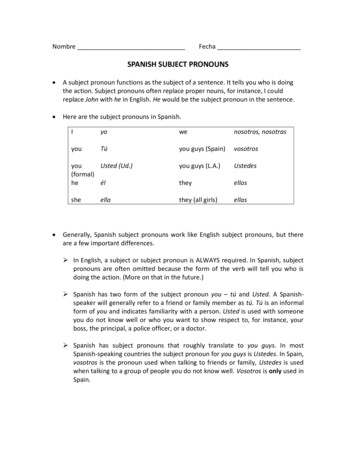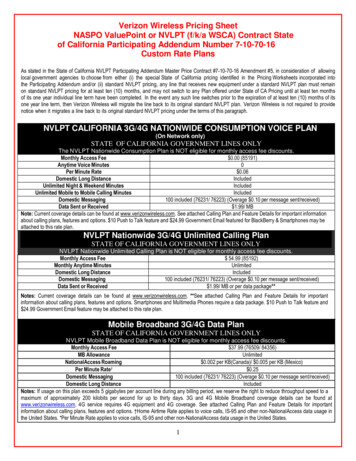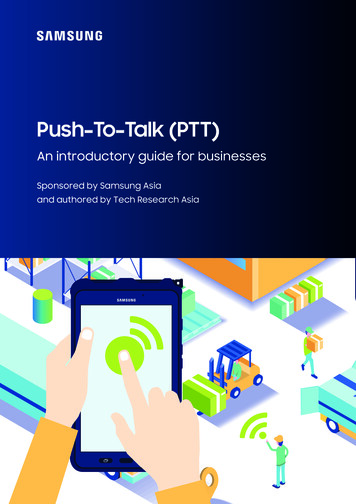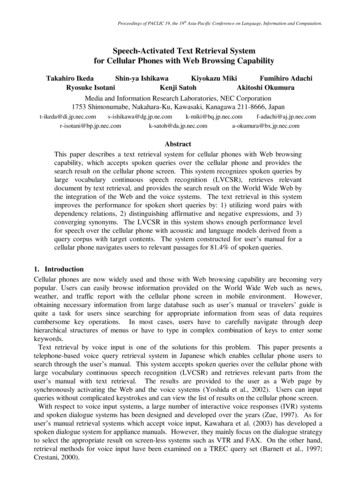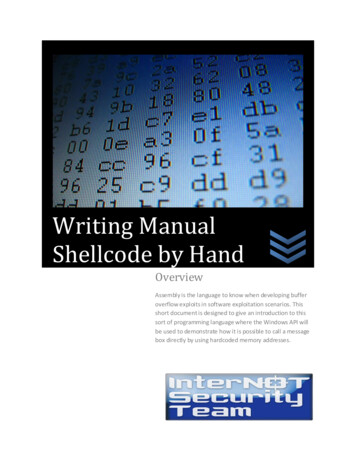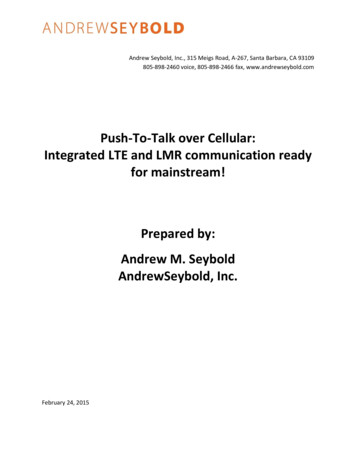
Transcription
Andrew Seybold, Inc., 315 Meigs Road, A-267, Santa Barbara, CA 93109805-898-2460 voice, 805-898-2466 fax, www.andrewseybold.comPush-To-Talk over Cellular:Integrated LTE and LMR communication readyfor mainstream!Prepared by:Andrew M. SeyboldAndrewSeybold, Inc.February 24, 2015
Executive SummaryToday’s wireless broadband and cellular users communicate in a variety of ways including text, email,and traditional dial-up two-way voice conversations. However, there is another very powerful form ofvoice communications now available on commercial wireless networks. This voice service provides oneto-one and one-to-many communications not only on the commercial network the user subscribes tobut, depending on the vendor, across multiple commercial networks, and it can be cross-connected toother similar types of voice communication systems.This is called “Push-To-Talk” or “PTT.” When used over commercial wireless systems it might also bereferred to as Push-to-Talk over Cellular or POC. PTT has been used by many organizations since the1930s, and it is the typical type of communications used in military and aviation communication. PTT isefficient and very fast. There is no need to enter a series of numbers, wait for the call to connect, ring,and then be answered. Instead, call setup is streamlined and connections are nearly instantaneous. PTTis not limited to one-to-one communications the way traditional wireless voice calls are. Users cancommunicate to and among groups of users spread out inside a single building or across the globe.After the advent of cellular service in 1991, PTT services were not offered by any of the commercialproviders until Nextel was formed in 1996. Nextel was the only PTT provider on a commercial networkand it made use of a proprietary PTT system. When Sprint took over Nextel, it, too, found a solution andadded PTT to its offering, which was, again, proprietary. Today, AT&T, Sprint, and Verizon all offer theirown versions of PTT and each of these is available only for use across their own networks.With the advent of third-generation (3G) and then fourth-generation (4G or LTE) technology, it becamepossible to create a push-to-talk over cellular system that would run across multiple wide-area networksas well as on in building or Wi-Fi systems. This type of system is gaining acceptance because it is notlimited to a single network operator or a small number of devices. One of the leading companies withinthis segment of the PTT market is SLA with its ESChat offering. SLA continues to add customers andcustomers that have been with SLA for a few years are signing new service agreements when theircurrent contracts expire. The fact that existing users are returning as longer-term customers speaks wellfor both the company and the product.Even though POC is available from many different vendors, each offering a different type of service, POCis still very much a niche market. The main reason for this is that today’s POC customers are people whohave previously used PTT on dedicated networks or the Nextel system. People who have grown up withonly cellular or wireless devices and have never experienced PTT do not have any idea of how powerfula tool it can be. Even the wireless network operators that offer PTT services on their networks are nottruly promoting it. If you walk into one of their company-owned stores and ask about PTT, the usualreaction is one of confusion since these salespeople are not trained or even exposed to their owncompany’s PTT offering.2
To be successful in the commercial push-to-talk market, certain high-performance elements must bepresent. The first is very fast setup time. When the first PTT user pushes the PTT button on the device oron the screen, he/she expects to be able to start talking immediately. However, there is always some lagtime to set up the connection. This time must be minimized and must be less than a second. Next is thevolley time where the first person lets go of the PTT switch and the second person responds. There canbe no delays in volley time or the system will frustrate the user community. In the world of Public Safetymission-critical communications the standard test for PTT timing is to depress the PTT switch and say,“Don’t Shoot,” into the microphone. If those listening do not hear the first word the system is too slow!There is another set of features and functions, many are must-haves and some are nice-to-haves. SLA’sESChat provides virtually all of these, enabling its users to interconnect with several types of existingLand Mobile Radio (LMR) PTT systems and dispatch consoles. ESChat provides PTT access to individualsand groups, and is capable of showing individual and group status. It supports preemption, and providesvoice encryption and GPS location across both the cellular and LMR networks. There are many POCcompanies both on the network and on the PTT application side, but few that can compete with thefeatures and functions of existing Land Mobile Radio PTT services. SLA’s ESChat stands out as the mostcomplete POC offering available today, and the company appears to be focused on maintaining thismarket position into the future.PTT over cellular or POC enables people who had carried two devices—one cell or smartphone and onetwo-way radio or LMR handheld radio—to now carry one cell phone or smartphone and still be able touse PTT with anyone on their existing LMR PTT system. This not only cuts down on the cost per person,it makes people more efficient and they don’t need to hear their LMR radio blaring while they are inmeetings or having discussions. Further, LMR PTT service is limited to a specific area, perhaps in a city,but POC is available nationwide. Thus those who have switched to POC not only gain the advantage of asingle device but also the advantage of being anywhere and being able to access their LMR networkand/or communicate with others on the LMR network.Today there are no nationwide or worldwide standards for POC. This has led to situations when PTTcapabilities across agencies or between companies will not work. While there appears to be a standardfor POC on the horizon, it will take a long time for it to be implemented. Further, it is only a standard for4G or LTE and it is not backward compatible with 3G systems, which today, are still prevalent inside andoutside the United States. There is a need, therefore, for companies offering POC to be able to provideinteroperability between companies and users. SLA with ESChat addresses this requirement and solvesthis problem as well.Push-to-talk over cellular should be used more widely than it is. There are many uses for instant one-toone and one-to-many communications. However, the PTT solution is not widely advertised or discussed,therefore it remains a niche service. The demand for POC is growing but mostly among those who haveexperienced push-to-talk either in their dedicated LMR systems or on the Nextel wireless network.3
Once wireless customers begin to understand the implications of fast one-to-one and one-to-manycommunications, the ability to see who is online and available for a call, and the other capabilitiesoffered by POC, it does not take long for them to want to try it themselves. Once they have tried POC,they almost always purchase the service. And then wonder how they ever got along without it.Andrew M. SeyboldCEO and Principal Consultant4
Push-To-Talk over Cellular:Integrated LTE and LMR communication ready for mainstream!IntroductionSince the 1930s, “Push-To-Talk” (PTT) has been used by the military, police, fire, EMS, and business andindustrial two-way radio users for conducting voice conversations over a radio channel. Over time, pushto-talk systems evolved to provide more capabilities, but its fundamental purpose is for one person at atime to be able to speak to one or more listeners simultaneously, and near instantly. No dial tone,simply push the PTT button and talk.This unique form of near-instantaneous communications is not possible with typical dial-up wirelessservices. The more important it is for people to communicate with each other in near-real time, themore important push-to-talk becomes. Today PTT is used by delivery services, hotels, utilities, within theservices sector, at conventions, in warehouses, and anywhere dispatchers must keep track of mobileresources and direct their positioning. Moreover, PTT is the primary form of wireless voicecommunications used within the Public Safety community.In traditional two-way radio systems (Land Mobile Radio (LMR)) the delay from the time the PTT buttonis pushed and the transmission begins is measured in milliseconds. When the user lets go of the PTTbutton another user can answer, again, within milliseconds. The timing of the “setup” and “volley” arecritical. For example, push the PTT button and say, “Don’t Shoot!” If listeners hear “Don’t shoot,” thesystem is functioning properly. If they miss the first word, the results are not as intended.Early competitors to LMR did not understand how critical fast setup and volley times are. Nextel’s PTTcame close to LMR times and provided a near-instantaneous “beep” to indicate connection to thenetwork, setup completion, and that a PTT conversation could begin. In its heyday, Nextel had morethan 18 million customers.Sprint purchased Nextel in 2005 and proceeded to deploy its own PTT service, moving customers off theNextel channels in order to implement broadband services on them. Shortly after the merger, Verizonand AT&T ventured into the push-to-talk market but were not competitive.With third-generation technology it became possible to provide adequate on-network PTT solutions andSprint, Verizon, and AT&T found solutions acceptable to users with previous PTT experience.Unfortunately, each network decided on a different vendor and technology and there was no possibilityof cross-network PTT service. SMS/texting did not become popular until it was available across multiplenetworks, the same was true for Multi-Media Services (MMS), and yet the networks are offeringproprietary PTT communications. These three networks combined have fewer PTT customers thanNextel in its heyday, primarily because their PTT services are confined to their own networks.5
The Next GenerationThe rapid development of third and then fourth-generation (LTE) wireless technology along with theexplosion in the numbers of smart devices and applications has offered an opportunity for somecompanies to see a broader market for PTT or what is being called PTT over Cellular (POC). Thesecompanies are providing POC as an application rather than yet another add-in to a commercial networkthat only works within that network. By building an application and the back-end infrastructure thatgoes with it, POC vendors can provide a solution that can be installed on virtually any device and willwork across different commercial networks as well as Wi-Fi networks.In fact, the POC application works over both Wi-Fi and commercial networks as more and more networkoperators offer voice and data access to their networks via Wi-Fi in order to off-load them. This is a realadvantage because many locations have in-building Wi-Fi but lack network coverage indoors. Becausethe POC application can use either path to provide PTT, the system works across networks and over WiFi for the best of all possible worlds and the broadest of coverages.One of the prime target markets calls for integration of POC with existing land mobile radio PTT systems.With this integration, upper management and administrative personnel can carry a single smartphoneand have access to typical wireless functions, and they can communicate across the commercialnetworks and back to their own private LMR system. The theory is that many companies with LMRsystems will, over time, move solely to POC and abandon their LMR system altogether. There are severalsuccess stories of companies that have deployed with this strategy and won large contracts over thepast year or so. One of the most successful companies in the POC application space is SLA Corporationwith its ESChat product offering.Knowing When POC Is a Solution and When It Is NotMany PTT or POC providers assume their technology can actually replace the land mobile radio systemsdeployed by the Public Safety community for dispatch, day-to-day operations, and during emergencies.This is simply not true! These LMR systems will remain in place for a long time because they are muchmore robust and fault tolerant than commercial networks. During times of large-scale incidents,commercial wireless networks tend to become overloaded and as a result, many customers cannotaccess the network. Obviously, this is not acceptable for the Public Safety community, especially sincethere are no provisions for priority access for the Public Safety community in the commercial wirelessworld.However, while this is true and correct, it does not allow for the fact that there are opportunities forPOC to be deployed within the Public Safety community. Once vendors realize dispatch and missioncritical services are not well suited for replacement by POC, they will discover that there are a number ofother uses for POC within the Public Safety community that make perfect sense. SLA Corporation6
understands the differences between mission-critical dispatch communications and non-mission-criticalor administrative communications.For example, a large number of Public Safety administrative personnel who work at desks or out in thecommunity are not considered first responders. Today, many of these people must carry both a smartwireless device and a handheld PTT radio in order to stay in touch with their agency. This group is ideallysuited for POC since with POC they could carry a single device and, just as important, the handheld radiowould not be interrupting their work or conversations but they would still be in instant communicationswith their agency.Another group of people who can and do benefit from POC is made up of off-duty but on-call personneland those who want or need to be aware of what is happening within their agency. With POC it isn’tnecessary for these people to carry a handheld radio as a second device. And then there are detectivesand plain clothes personnel who need to be inconspicuous, and in some cases need to be able tocommunicate with others but don’t want to listen to routine communications traffic or have their radioblast out a dispatch as they are engaged in a covert operation.Another valid reason for making use of POC within the Public Safety community is that it is easy forcitizens to monitor the two-way radio channels employed by most departments. While encryption isbeing used more and more, there are still many agencies across the United States that can be monitoredusing an application on a smartphone or an inexpensive radio scanner. A really good POC application willinclude high levels of voice encryption to ensure privacy during communications.Other potential customers for a good POC multi-network solution include utility companies,transportation companies such as trucking, taxi, limo, and perhaps even services such as Uber.Healthcare providers are a significant group of PTT service users as are construction workers, manytypes of educational institutions, especially schools with school bus services, and the hospitalityindustry. Many of these organizations are already familiar with PTT since they have previously used landmobile radio and/or Nextel PTT services. The fact that even those who use LMR PTT services today alsocarry a smart wireless device for use over the commercial wireless networks is one of the mostcompelling reasons for switching to POC.Today, the push-to-talk over cellular or POC marketplace has many apparent contenders. However, onceyou look at what it takes to be a serious contender in the POC market, the number of potentialcompetitors shrinks. In this market it takes more than a simple application that provides push-to-talklike service over one or more network to be truly competitive. First, of course, is the issue of time ittakes to set up the call and then the volley time or time between responses, both of which are criticallyimportant, especially for those who have been using push-to-talk over land mobile radio systems orNextel. The premise of PTT service is that it is near instantaneous and provides access to one or manydifferent people at once. If there are setup delays or if people have to wait for some period of time afterthe transmission before they can respond, they simply won’t use the system.7
A PTT system needs to have many other attributes beyond the time it takes to start and continue a PTTconversation. The word “system” rather than “application” is appropriate here because in order toprovide the types of services expected by existing and potential PTT services, it is important that the PTTvendor provide best-in-class voice quality, which requires the use of variable rate codecs and errorcorrection. The system must be flexible and enable one-to-one and one-to-many communicationsbetween and among existing LMR radios, the dispatch center, and POC users. The experience must beseamless, easy to use, and without any type of system delays.The features outlined above are only a small portion of what needs to be available to provide servicesfor the customer base. Today, location on a near-real-time basis is vitally important and must be sharedacross all of the platforms, and text messaging has also become a must-have. Perhaps the mostimportant requirement for POC vendors is to provide interfaces not only to LMR analog radio systems,which have been in existence for more than thirty years, but also to the newer digital voice systems. Thisincludes the P25 standard for Public Safety as well as DMR, NEXEDGE, MOTOBRO, TETRA, and others.The type of voice network the POC device it is interfaced with should not matter. It simply must work.Beyond these absolute requirements are others that enable users to define groups of people to beincluded in a PTT conversation while excluding others. The number of groups and the size of each groupvaries from vendor to vendor. However, the larger the organization to be served with PTT, the moreflexibility is required when it comes to groups and the number of individuals within each group. Whengroup technology was first offered by Nextel it had to be set up on a PC, so building new groups wasawkward. Today, groups must be able to be created from the device and on the fly so there is flexibilityin how people communicate. In many cases today, groups are defined not only within a singleorganization but also between organizations. For example, a County Sheriff’s key personnel might havea POC system tied to their own dispatch and LMR systems and another group that providesinteroperability between the County Sheriff and various local police departments, or perhaps betweenthe Sheriff and the fire departments. One of the major issues for Public Safety LMR users is that theyoften cannot communicate between agencies during emergencies. However, the POC system can bridgethis gap and provide an additional level of coordination. The caveat is that commercial networks havenot been designed to provide mission-critical communications and during times of large-scaleemergencies commercial wireless networks may not be available for Public Safety use. Thus legitimatePOC vendors will not try to convince Public Safety agencies that they can replace their day-to-day LMRdispatch systems.The advent of commercial broadband services has been seen by a very few POC vendors as anopportunity to enhance their product offerings by adding features and functions. The push-to-talksystems used from the 1930s until the early 2000s have given way to much more robust offerings andhave empowered customers with features and functions they have come to rely on. Today’s PTT overcellular matches the advanced functions found on the most modern land mobile radio systems.8
However, since POC is based on broadband technologies, POC is able to add features and functions thatare not available over LMR PTT systems today.The Market for PTTIn 2005, Nextel had more than 20 million subscribers on its cellular network and PTT service offering.Including Public Safety’s 4 to 6 million PTT land mobile radios, there were reportedly an additional 50million PTT LMR users in the United States. Today these numbers have dwindled considerably. However,while land mobile radio continues to lose customers, the commercial wireless PTT market is growing at asimilar pace as many ex-Nextel customers search for options, companies with LMR systems explore theiroptions, and Public Safety and other agencies turn to POC to off-load administrative and non-essentialtraffic in order to free up their oft-times overloaded mission-critical networks for dispatch andemergency calls.The total available market for POC is difficult to quantify because it not only includes ex-Nextelcustomers and those making use of LMR systems but others who, through marketing efforts, will beexposed to POC and find it can be beneficial in assisting them in their daily lives. So far, most of themarketing efforts have been aimed at ex-Nextel and existing LMR users who can be considered “lowhanging fruit” because they are already familiar with PTT and its advantages. However, over time,companies that want to thrive and grow in the POC marketplace will branch out to educate manycompanies that have never experienced PTT and then sell POC services to them.One of the advantages companies such as SLA with its ESChat solution has is that it works over multiplenetworks and Wi-Fi as well. The big three commercial network operators have built PTT into theirnetworks but because the PTT technologies are different, there is no really good way for them to offerPTT across multiple networks. PTT needs to be network agnostic if it is to gain market acceptance. Allyou have to do is to look back in time to understand that technical advances became mainstream onlyafter they were available across networks. This was true with text messaging (SMS) and MultimediaMessaging Services (MMS) that enable attachment of pictures and other content. In some ways this alsoapplies to cellular voice, which grew slowly until roaming agreements between networks were in place.As long as network operators do not provide cross-network PTT services, ESChat and other “over thetop” POC services will continue to have a decided advantage.Push-To-Talk StandardsAs mentioned, today there is no one standard for push-to-talk over cellular. Two competingorganizations are currently working on a standard. The first is the Open Mobile Alliance or OMA, whichdoes not appear to have the support of the network operators or many of the existing POC vendors.Another is the 3GPP, which is the standards body that has published the standards for fourth-generationLTE technology. The 3GPP has included a PTT standard in its work product that will be finalized andreleased in the next year or two but won’t be available for commercialization until at least 2018.9
Further, since the 3GPP standard is an LTE standard it is doubtful that it will be backward compatiblewith existing 3G systems. Since 3G systems cover more of the world than LTE systems today, having anLTE-only standard will not provide the same level of PTT coverage as existing services that work on both3G and 4G networks. Again, the best way to promote push-to-talk over cellular is to make it availableacross all networks as well as Wi-Fi. Network-centric solutions are proprietary and prevent customers ondifferent networks from taking part in PTT conversations. This makes it especially difficult for thosetrying to manage “Bring Your Own” device programs within corporations.Perhaps the most important must-have for a serious PTT vendor is the ability to connect POC andexisting LMR systems together. This is important for a number of reasons. First, if a company wants totry it out to see if POC meets its needs it can keep its LMR system up and running. By running bothsystems, it can provide POC devices to executives and some of the workforce and let them try theservice while staying in touch with those using the company’s LMR system. For Public Safety, enablingsenior officers to carry a single device and still stay in contact with their dispatch center or talk via theirPOC devices over one of their LMR radio channels is a must. Further, detectives and others who mightbe in undercover operations certainly do not want to be seen with a two-way radio on their belt eventhough they still have a need to talk among themselves and oftentimes back to the dispatch center ordirectly to incoming units that are on the LMR system.SLA’s Push-To-Talk over Cellular (POC) SolutionAs mentioned above there are many contenders offering various types of POC services. Some servicesare even offered for free, but very few of the serious contenders can provide all the features, functions,and flexibility needed for a great user experience and POC flexibility. SLA’s ESChat is one of the bestexamples available today for a POC system that meets and exceeds all the requirements spelled outabove. ESChat was not designed for friends and family use but rather to replace and/or augmentexisting professional grade PTT services. It is robust, secure, and can be configured in many differentways to provide even greater levels of security, making it an ideal choice for government entities as wellas businesses concerned about security.Some companies that supposedly compete in the POC field simply provide an application that functionslike a poor man’s push-to-talk with few features and slow response times. SLA, on the other hand,provides more than an application for a host of devices including Apple, Android, and Windows devices.It is a system that includes back-end infrastructure to secure the communications, manage the devices,provide interfaces between various voice protocols, and much more. ESChat can be deployed makinguse of the SLA servers so no infrastructure is required at your location. It can be deployed using hostingoptions including Amazon AWS Cloud and for government entities and the Amazon AWS GovCloud, orSLA can provide on-premise infrastructure for those who want complete control over their POC system.Moreover, ESChat can be installed in closed and secure networks run by third parties or customersthemselves without using the Internet for connectivity.10
When the system is installed, clients are installed on the devices, and the POC connection is made.ESChat is easy to use, it supports secure PTT voice, secure text and image messaging, and real time (live)as well as historical location tracking and mapping. This last feature enables clients to track their units inthe field and, when necessary, backtrack to see where they have been.The SLA system is secure from end to end, and this includes the smartphone devices used in the system,the connections to and from existing Public Safety or business LMR radio networks, and securecommunications between the POC devices and dispatch consoles. In many cases, SLA is also able tointegrate its solution with existing Computer Aided Dispatch (CAD) systems.SLA first deployed ESChat in 2008 on the Verizon Wireless network for a military installation that neededmore PTT functionality than that offered by Verizon’s own PTT service. SLA has continued to upgradeand enhance ESChat so it works well across LTE (fourth-generation technology) and Wi-Fi, and it is stillbackward compatible with existing 3G networks. While Verizon also offers its own “baked into thenetwork” PTT solution, it continues to provide ESChat to its customers and enables Verizon customers toadd ESChat’s service charges to their Verizon bill. Further, ESChat is available to all government agenciesbecause it is approved for purchase by the GSA (General Services Administration), as well as directlyfrom SLA Corporation. SLA also provides support for third-party developers that want to build on top ofthe ESChat functionality. Included in this support are an SDK available for third-party integration thatprovides access to Apple devices (iOS), Android Devices, and PCs, both as a client and a dispatch tool,and ESChat is easily integrated with most existing dispatch consoles and Computer Aided Dispatch (CAD)systems.PTT Features and FunctionsAs land mobile radio evolved from analog to digital, PTT capabilities increased as well. In the earliestdays of PTT, everyone on the same LMR radio channel heard all of the PTT traffic on that channel, eventraffic that was not directed to them. Today, LMR PTT services include fully encrypted PTT, the ability todivide the PTT population into various groups and sub-groups, and in some cases the ability to track thelocation of a user or vehicle with GPS tracking. Companies such as SLA with ESChat have not onlyprovided all of the features and functions available over LMR for PTT, they have provided even morefunctionality because of the advanced capabilities of 3G and 4G broadband technology. Some of thesefeatures are secure group multimedia text and image transmission and live mapping and tracking ofdevice locations including being able to track devices back in time.There are many more features and functions provided by ESChat (see Appendix A), but the bottom lineis that SLA started with a basic, very fundamental form for voice technology and enhanced it in manydifferent ways. Today, POC features go well beyond what is available with the most modern PublicSafety digital networks, primarily because of the added bandwidth and capacity provided by today’scommercial broadband technologies.11
POC ContendersThe POC market is crowded with companies that all claim to have the best solution. As mentioned,AT&T, Sprint, and Verizon all offer their own proprietary flavor of a networked-based PTT ser
PTT over cellular or POC enables people who had carried two devices—one cell or smartphone and one two-way radio or LMR handheld radio—to now carry one cell phone or smartphone and still be able to use PTT with anyone on their existing LMR PTT system. This not only cuts down on the cost per person,

